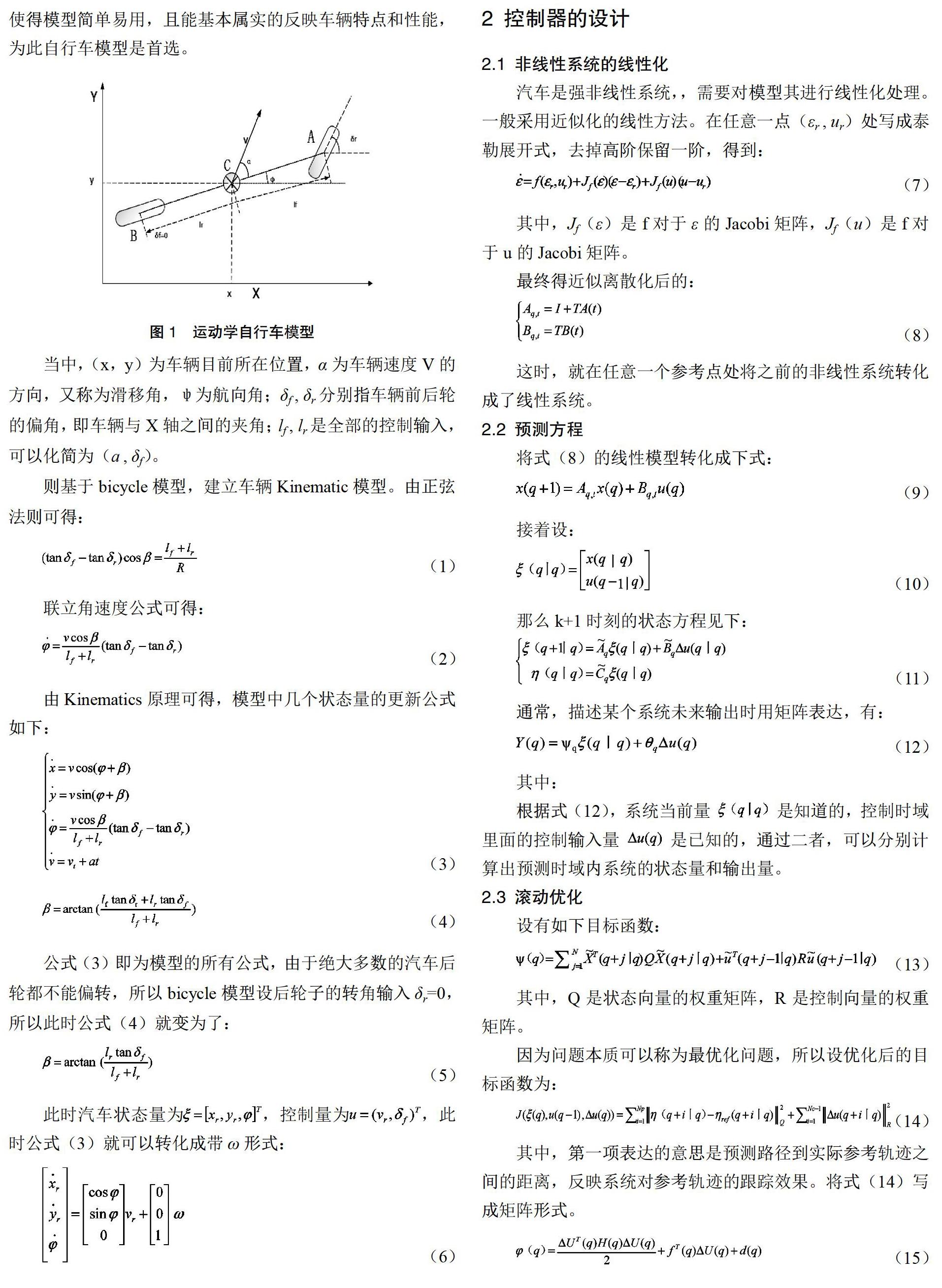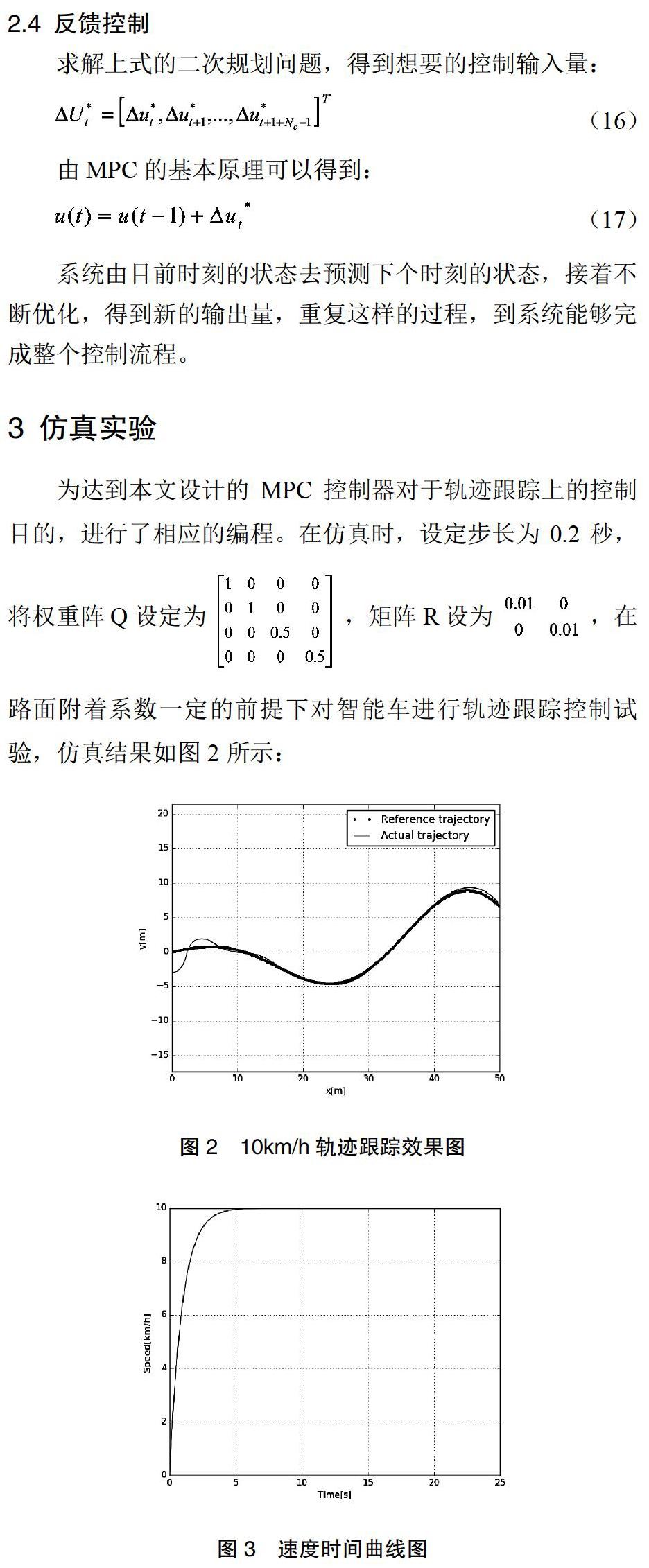基于模型预测控制的智能车轨迹跟踪控制研究
2020-05-06牛亚明邵金菊沈刚李训意魏国
牛亚明 邵金菊 沈刚 李训意 魏国


摘 要:为了完成智能车的轨迹跟踪,提出一种基于模型预测控制的轨迹跟踪方法,利用将运动学模型这个非线性系统线性化的方案,来获得必须的线性时变系统,采取模型预测控制的三要素来设计控制器。并且基于MPC在控制过程中能增加多种约束的优点,建立基于车辆运动学模型的约束做轨迹跟踪仿真实验,最后,基于山东理工大学智能车平台上GPS提供的定位信息,在校园中采集路线并对前提规划好的的轨迹进行实车验证。实验结果表明:基于MPC算法所设计的控制器能快速且稳定地跟踪期望轨迹。
关键词:模型预测控制;线性化;轨迹跟踪;定位
中图分类号:U461 文献标识码:A 文章编号:1671-7988(2020)06-34-03
Abstract: In order to complete the trajectory tracking of smart cars, a trajectory tracking method based on model predictive control is proposed. The linearization of the nonlinear system of the kinematic model is used to obtain the necessary linear time-varying system. The three elements of model predictive control are adopted. To design the controller. And based on the advantages that MPC can add a variety of constraints in the control process, a trajectory tracking simulation experiment is established based on the constraints of the vehicle kinematics model. Finally, based on the positioning information provided by the GPS on the intelligent vehicle platform of Shandong University of Technology, routes are collected on campus The real-world vehicle verification is performed on the trajectory planned in the premise. The experimental results show that the controller based on the MPC algorithm can track the desired trajectory quickly and stably.
Keywords: Model predictive control; Linearization; Trajectory tracking; Localization
CLC NO.: U461 Document Code: A Article ID: 1671-7988(2020)06-34-03
前言
模型預测控制(MPC)可以对系统输出量进行反馈矫正,使误差最小化来提高系统的鲁棒性。本文率先建立了车辆的运动学模型,之后对其进行线性化得到相应的线性模型,再利用模型预测控制三要素预测方程建立、滚动优化以及反馈校正来设计控制器;实验设计是以山东理工大学的哈佛H7改装智能车为平台处理的,最后试验仿真及行车试验,验证控制效果。
1 车辆运动学模型的建立
在建立车辆运动学模型之前,要率先简化汽车运动,以使得模型简单易用,且能基本属实的反映车辆特点和性能,为此自行车模型是首选。
在仿真中,设置的汽车速度为10km/h,其中图3中红色的线段是智能车跟踪的参考轨迹,也叫做期望轨迹,蓝色线段是汽车实际在跟踪过程中行驶轨迹;图6是速度时间变化曲线,从图中可看出,汽车速度从0开始加速,一直加速到10km/h,之后不再变化。
从仿真结果可知,智能车在模型预测控制器的作用下能够能够在低速运动时比较快速且很准确的跟踪上期望轨迹。
4 结论
实验证明,本文所设计的模型预测控制器使得车辆在中低速时可以具有良好的鲁棒性,很好的实现了在校园规定路径下的轨迹跟踪实验。
参考文献
[1] 车辆起步MPC控制器设计及FPGA实现[J].许月亭,陈虹,季冬冬,许芳.控制工程. 2015(05).
[2] Linear time-Varying Model Predictive Control and its Application to Active Steering Systems: Stability Analysis and Experimental Validation[J].P.Falcone,F.Borrelli,H.Multi-Objective Control Synthe -sis: an Application to 4WS Passenger Vehicles[J].S.-S. You,Y.-H. Chai. Mechatronics . 1999 (4).
[3] 基于模型预测控制的无人驾驶车辆轨迹跟踪控制算法研究[D]. 孙银健.北京理工大学,2015.
[4] Optimal Synchronous Trajectory Tracking Control of Wafer and Reticle Stages[J].王春洪,胡金春,朱煜,尹文生.Tsinghua Science and Technology. 2009(03).
[5] 赵洁.智能车辆的路径跟踪及底层控制研究[D].吉林大学,2018.
[6] 王艺,蔡英凤,陈龙,王海,何友国,李健.基于模型预测控制的智能网联汽车路径跟踪控制器设计[J/OL].机械工程学报.
[7] 段建民,田晓生,夏天,宋志雪.基于模型预测控制的智能汽车目标路径跟踪方法研究[J].汽车技术,2017(08):6-11.
[8] 焦巍,刘光斌.非线性模型预测控制的智能算法综述[J].系统仿真学报.
[9] Gong P, Yang J, Ma C, et al. Research on Multi-Point Monitoring Anti-Collision System for Vehicle Auxiliary Driving[J].Optik- Inter -national Journal for Light and Electron Optics, 2016, 127(18):7121 -7127.
[10] 模型预测控制[M].科学出版社,陈虹,2013.
